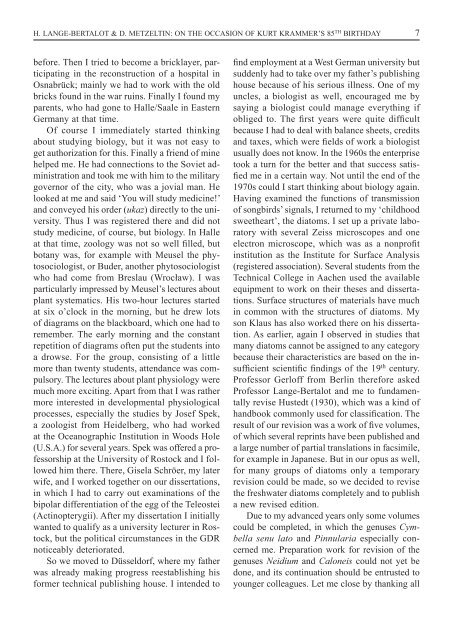Pbj551_s001-26.pdf
Pbj551_s001-26.pdf
Pbj551_s001-26.pdf
Create successful ePaper yourself
Turn your PDF publications into a flip-book with our unique Google optimized e-Paper software.
H. LANGE-BERTALOT & D. METZELTIN: ON THE OCCASION OF KURT KRAMMER’S 85 TH BIRTHDAY 7<br />
before. Then I tried to become a bricklayer, participating<br />
in the reconstruction of a hospital in<br />
Osnabrück; mainly we had to work with the old<br />
bricks found in the war ruins. Finally I found my<br />
parents, who had gone to Halle/Saale in Eastern<br />
Germany at that time.<br />
Of course I immediately started thinking<br />
about studying biology, but it was not easy to<br />
get authorization for this. Finally a friend of mine<br />
helped me. He had connections to the Soviet administration<br />
and took me with him to the military<br />
governor of the city, who was a jovial man. He<br />
looked at me and said ‘You will study medicine!’<br />
and conveyed his order (ukaz) directly to the university.<br />
Thus I was registered there and did not<br />
study medicine, of course, but biology. In Halle<br />
at that time, zoology was not so well fi lled, but<br />
botany was, for example with Meusel the phytosociologist,<br />
or Buder, another phytosociologist<br />
who had come from Breslau (Wrocław). I was<br />
particularly impressed by Meusel’s lectures about<br />
plant systematics. His two-hour lectures started<br />
at six o’clock in the morning, but he drew lots<br />
of diagrams on the blackboard, which one had to<br />
remember. The early morning and the constant<br />
repetition of diagrams often put the students into<br />
a drowse. For the group, consisting of a little<br />
more than twenty students, attendance was compulsory.<br />
The lectures about plant physiology were<br />
much more exciting. Apart from that I was rather<br />
more interested in developmental physiological<br />
processes, especially the studies by Josef Spek,<br />
a zoologist from Heidelberg, who had worked<br />
at the Oceanographic Institution in Woods Hole<br />
(U.S.A.) for several years. Spek was offered a professorship<br />
at the University of Rostock and I followed<br />
him there. There, Gisela Schröer, my later<br />
wife, and I worked together on our dissertations,<br />
in which I had to carry out examinations of the<br />
bipolar differentiation of the egg of the Teleostei<br />
(Actinopterygii). After my dissertation I initially<br />
wanted to qualify as a university lecturer in Rostock,<br />
but the political circumstances in the GDR<br />
noticeably deteriorated.<br />
So we moved to Düsseldorf, where my father<br />
was already making progress reestablishing his<br />
former technical publishing house. I intended to<br />
fi nd employment at a West German university but<br />
suddenly had to take over my father’s publishing<br />
house because of his serious illness. One of my<br />
uncles, a biologist as well, encouraged me by<br />
saying a biologist could manage everything if<br />
obliged to. The fi rst years were quite diffi cult<br />
because I had to deal with balance sheets, credits<br />
and taxes, which were fi elds of work a biologist<br />
usually does not know. In the 1960s the enterprise<br />
took a turn for the better and that success satisfi<br />
ed me in a certain way. Not until the end of the<br />
1970s could I start thinking about biology again.<br />
Having examined the functions of transmission<br />
of songbirds’ signals, I returned to my ‘childhood<br />
sweetheart’, the diatoms. I set up a private laboratory<br />
with several Zeiss microscopes and one<br />
electron microscope, which was as a nonprofi t<br />
institution as the Institute for Surface Analysis<br />
(registered association). Several students from the<br />
Technical College in Aachen used the available<br />
equipment to work on their theses and dissertations.<br />
Surface structures of materials have much<br />
in common with the structures of diatoms. My<br />
son Klaus has also worked there on his dissertation.<br />
As earlier, again I observed in studies that<br />
many diatoms cannot be assigned to any category<br />
because their characteristics are based on the insuffi<br />
cient scientifi c fi ndings of the 19 th century.<br />
Professor Gerloff from Berlin therefore asked<br />
Professor Lange-Bertalot and me to fundamentally<br />
revise Hustedt (1930), which was a kind of<br />
handbook commonly used for classifi cation. The<br />
result of our revision was a work of fi ve volumes,<br />
of which several reprints have been published and<br />
a large number of partial translations in facsimile,<br />
for example in Japanese. But in our opus as well,<br />
for many groups of diatoms only a temporary<br />
revision could be made, so we decided to revise<br />
the freshwater diatoms completely and to publish<br />
a new revised edition.<br />
Due to my advanced years only some volumes<br />
could be completed, in which the genuses Cymbella<br />
senu lato and Pinnularia especially concerned<br />
me. Preparation work for revision of the<br />
genuses Neidium and Caloneis could not yet be<br />
done, and its continuation should be entrusted to<br />
younger colleagues. Let me close by thanking all

















